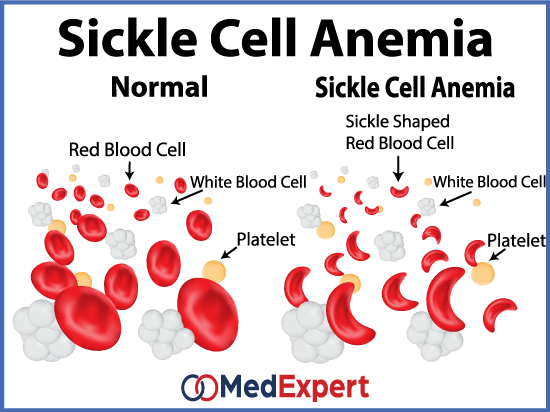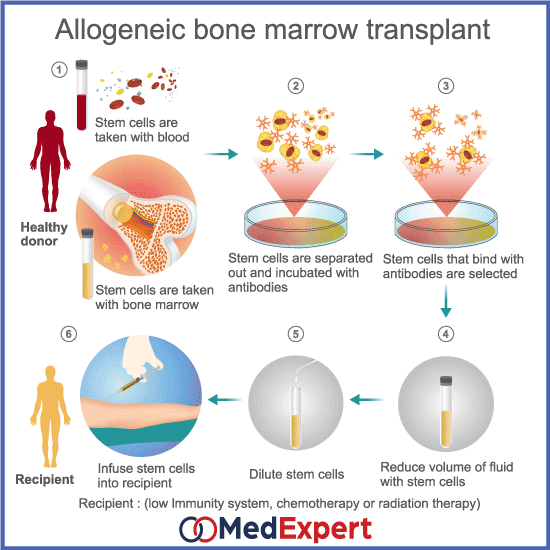SICKLE CELL ANAEMIA
Sickle cell anaemia is an inherited form of anaemia — a condition in which there aren’t enough healthy red blood cells to carry adequate amounts of oxygen throughout your body.

Normally, your red blood cells are flexible and round, moving easily through your blood vessels, however in sickle cell anaemia; the red blood cells become sticky and rigid and are shaped like sickles or crescent moons. This irregularity in shape can cause your red blood cells to get caught in small blood vessels, which can potentially slow or block blood flow and oxygen to different parts of your body.
Sickle cells are fragile and break apart easily causing them to die. This leaves you without an adequate supply of red blood cells. Red blood cells usually live for about 120 days before they die and need replacing. Sickle cells on the other hand, die after an average of less than 20 days, resulting in a lasting shortage of red blood cells (anaemia).
Although long-term treatment can help manage many of the problems associated with sickle cell anaemia, it is a serious and lifelong condition.
SYMPTOMS OF SICKLE CELL ANAEMIA
Signs and symptoms of sickle cell anaemia often don’t appear until an infant is at least 4 months old and at this time may include:
- Fatigue: Without enough red blood cells in circulation, your body can’t get the sufficient amounts of oxygen it needs to feel energized. That’s why anaemia causes fatigue.
- Episodes of pain: Periodic episodes of pain, called crises, are a major symptom of sickle cell anaemia. This pain develops when the deformed, sickle-shaped red blood cells block blood flow through tiny blood vessels to your chest, abdomen and joints. This pain may vary in intensity and can last for as little as a few hours to as long as a few weeks. Whilst some people experience only a few episodes of pain, others experience a dozen or more crises a year. Hospitalization may be required if the crises is severe enough.
- Hand-foot syndrome: Swollen hands and feet are often among the first signs of sickle cell anaemia in babies. The swelling is caused by sickle-shaped red blood cells blocking the blood flow out of their hands and feet.
- Frequent infections: Sickle cells can damage your spleen, an organ that is responsible for fighting infection. Having a damaged spleen may make you more vulnerable to developing infections. Doctors commonly give infants and children with sickle cell anaemia vaccinations and antibiotics to prevent potentially life-threatening infections, such as pneumonia.
- Delayed growth: Red blood cells provide your body with the oxygen and nutrients you need for healthy growth. A shortage of healthy red blood cells can cause growth to slow down in infants and children and delay puberty in teenagers.
- Vision problems: Some people with sickle cell anaemia experience vision problems. This happens when the tiny blood vessels that supply your eyes become plugged with sickle cells. This can do damage to your retina(s) — the portion of the eye that processes visual images.

TREATMENT OPTIONS AVAILABLE FOR SICKLE CELL ANAEMIA
Bone marrow transplant:
A stem cell transplant – also known as a bone marrow transplant – involves replacing bone marrow affected by sickle cell anaemia with healthy bone marrow from a donor. As there are considerable risks associated with a stem cell transplant – such as the body rejecting the new bone marrow – this procedure is recommended only for people who have severe symptoms and problems caused from sickle cell anaemia.
Treatment of sickle cell anaemia is usually aimed at avoiding crises, relieving symptoms and preventing further complications.

MEDICATIONS FOR SICKLE CELL ANAEMIA
- Antibiotics: Children who have sickle cell anaemia may begin by taking the antibiotic penicillin when they’re about 2 months of age and continuing to take it until they’re at least 5 years old. Doing this helps to prevent infections, such as pneumonia. This can be potentially fatal to an infant or child with sickle cell anaemia. Adults suffering from sickle cell anaemia are often given antibiotics to help fight certain infections.
- Pain-relieving medications: In order to relieve pain during a crisis, your doctor may advise over-the-counter pain relievers coupled with the application of heat to the affected area. Stronger prescription pain medication may also be required.
- Hydroxyurea (Droxia, Hydrea): When taken daily, hydroxyurea reduces the frequency of painful crises and may also reduce the need for blood transfusions. Hydroxyurea works by stimulating the production of fetal haemoglobin — a type of haemoglobin found in newborns that helps prevent sickle cells from forming.. Hydroxyurea, however, increases your risk of infections as well as potentially causing tumours or leukaemia in some people who take this drug for extended periods of time.While this is a concern, this hasn’t yet been seen in studies of the drug.Initially, hydroxyurea was used solely for adults with severe sickle cell anaemia, however, studies on children have shown that this drug may prevent some serious complications associated with sickle cell anaemia. Despite this, the long-term effects of hydroxyurea on children are still unknown. Speaking to your doctor can help you determine if this drug may be beneficial for you or your child.
DIAGNOSING SICKLE CELL ANAEMIA
- Blood test: A blood test can check for haemoglobin S — the defective form of haemoglobin that is associated with sickle cell anaemia.


